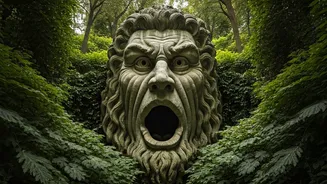A World of Wonder
Sacro Bosco, also known as the Park of Monsters, is a 16th-century garden near Bomarzo, in the province of Viterbo, Italy. It was commissioned by Pier
Francesco Orsini, also called Vicino, a soldier and patron of the arts, after he survived a war and mourned the death of his wife. The park is filled with bizarre and surreal sculptures carved from volcanic rock. These sculptures include mythical creatures, fantastical animals, and architectural structures that challenge traditional design. The atmosphere is intended to be disorienting and thought-provoking. The irregular layout and unconventional sculptures make the garden a unique experience. Unlike other gardens of the time, Sacro Bosco was not designed to be beautiful or symmetrical. Instead, it aimed to evoke a sense of wonder and bewilderment. The park's unconventionality reflects Orsini's personal journey and grief.
The Sculptures' Story
The sculptures scattered throughout Sacro Bosco are a collection of mythological figures, fantastical beasts, and enigmatic structures. They were sculpted by the architect Pirro Ligorio, after the designs of Orsini. Each sculpture tells a story or represents a particular idea, often reflecting Orsini’s personal experiences and beliefs. The most famous sculptures include the enormous Orc, a monstrous figure with an open mouth that visitors can enter, the leaning house, which creates a disorienting effect, and the turtles and elephants that carry obelisks. There are also sculptures of mythological figures such as Hercules and Cerberus. The sculptures are not arranged in a logical or ordered way. Instead, they are placed to create a sense of mystery and surprise. The combination of the sculptures' unusual forms and placements makes a visit to Sacro Bosco a truly immersive and unforgettable experience.
Exploring the Park
Wandering through Sacro Bosco is an adventure in itself. Visitors are encouraged to explore the park at their own pace, discovering its hidden corners and appreciating the details of each sculpture. The irregular paths and unexpected turns create a sense of disorientation, adding to the park's surreal atmosphere. As you walk, you'll encounter a variety of architectural and sculptural elements. These include the so-called 'leaning house', where a slanted structure affects the perceptions of those who enter, and the 'temple', a small building that provides a tranquil space. Visitors can also find inscriptions and poems throughout the park, which further enhance the atmosphere and stimulate reflection. The park's diverse layout makes each visit a different experience. The best way to enjoy Sacro Bosco is to embrace the unexpected and let your imagination run wild.
A Lasting Legacy
Sacro Bosco has fascinated visitors for centuries and continues to inspire artists and designers. It’s an early example of a Mannerist garden, which rejects the symmetrical and orderly designs of the Renaissance. The park's unique features have influenced later works of art and architecture, including surrealist art and modern garden designs. The park's enduring appeal lies in its ability to challenge expectations and spark imagination. It encourages viewers to think beyond traditional forms of beauty and embrace the unexpected. Today, Sacro Bosco is a popular destination for tourists, art enthusiasts, and anyone seeking a unique travel experience. It is a testament to human creativity and the power of art to express emotions and ideas. The enduring allure of Sacro Bosco proves that it remains a timeless work of art.









